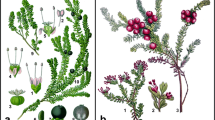Abstract
Native to Brazil,Schinus terebinthifolius Raddi, of the family Anacardiaceae, has been commonly cultivated in Florida for over 50 years as a dooryard ornamental. Use of its sprays of showy red fruits for Christmas decoration gave rise to the popular misnomer “Florida holly.” Too late it was found to become a large, spreading tree; aggressive seedlings began springing up near and far. Jungles ofSchinus have crowded out native vegetation over vast areas of Florida and the Bahamas, as in all the islands of Hawaii. When in bloom, the tree is a major source of respiratory difficulty and dermatitis; the fruits, in quantity, intoxicate birds and cause fatal trauma in four-footed animals. The abundant nectar yields a spicy commercial honey and beekeepers are opposed to eradication programs.
Similar content being viewed by others
Bibliography
Anaya, A. L. & A. Gómez-Pompa. 1971. Inhibitión del crecimiento por el “Piru” (Schinus molle L.). Rev. de la Sociedad Mexicana de Historia Natural 32: 99–109.
Berry Banquet Leaves 115 Birds Dead in South Dade. Miami Herald, March 2, 1978. P. C-1.
Blackwell, W. H., {jrJr.} & C. H. Dodson. 1968. Anacardiaceae. Pt. VI. Flora of Panama. Ann. Missouri Bot. Gard. 54(3): 351–379.
Borio, E. B. L., C. Cecy & Y. Yasumoto. 1973. Pharmacognostic study of the bark ofSchinus terebinthifolius Raddi—Anacardiaceae. Cienc. Cult. (São Paulo) 25(2): 631–634. [Abs.]
Burkill, I. H. 1935. Dictionary of the economic products of the Malay peninsula. 2 vols. Crown Agents for the Colonies, London.
Cruz, G. L. 1965. Livro verde das plantas medicinais e industriais do Brasil. Vols. I & II. Velloso, S. A., Belo Horizonte, Brasil.
Degener, O. 1946. Flora Hawaiiensis (Books 1–4). Otto Degener, Riverdale, New York.
Feldman, H. T., M. D., P. A., Personal communication, May 26, 1977.
Freise, F. W. 1934. Plantas medicinaes Brasileiras. Instituto Agronomico do Estado, Sao Paulo, Brazil. Pp. 252–94.
Gogue, G. J., C. J. Hurst & L. Bancroft. 1974. Growth inhibition bySchinus terebinthifolius. Paper presented at annual meeting of American Society for Horticultural Science, Guelph, Ontario, Canada. Aug. 14, 1974.
Gubb, A. S. 1911 (?). The Flora of the Riviera. Bailliere, Tindall & Cox, London.
Hoehne, F. C. 1939. Plantas e substancias vegetais toxicas e medicinais. Departamento do Botanico do Estado, Sao Paulo, Brazil.
Hosaka, E. Y. & A. Thistle. 1954. Noxious plants of the Hawaiian ranges. Exten. Bull. 62. Univ. of Hawaii, College of Agriculture, in cooperation with U.S. Dept. Agri.
Hoyt, R. S. 1958. Check lists for ornamental plants of subtropical regions. Livingston Press, San Diego, California.
Kaistha, K. K. & L. B. Kier. 1962. Structural studies on terebinthone fromSchinus terebinthefolius. J. Pharm. Sci. 51(3): 245–248.
— & —. 1962. Structural studies on terebinthone fromSchinus terebinthefolius. J. Pharm. Sci. 51(12): 1136–1194.
Klukas, R. W. 1969. The exotic plant problem in Everglades National Park. The Anhinga (April): 1–3.
Little, E. L., {jrJr.}, R. O. Woodbury & F. H. Wadsworth. 1974. Trees of Puerto Rico and the Virgin Islands. Vol. II. Agr. Handbk 449. United States Department of Agriculture, Forest Service, Washington, D.C.
Lloyd, H. A., Laboratory of Chemistry, National Heart, Lung and Blood Institute. Personal communication, Jan. 19, 1977.
—, T. M. Jaouni, S. L. Evans & J. F. Morton. 1977. Terpenes ofSchinus terebinthifolius. Phytochemistry 16: 1301–1302.
Manfred, L. 1947. 7,000 recetas botánicas, a base de 1300 plantas medicinales americanas. Editorial Kier, Buenos Aires, Argentina.
Mors, W. B. 1966. Useful plants of Brazil. Holden-Day, Inc., San Francisco, California.
Morton, J. F. 1954–1978. File notes of cases ofSchinus reactions investigated as Consultant for Poison Control Centers of Florida.
—. 1958. Ornamental plants with poisonous properties. Proc. Florida State Horticultural Society 71: 372–380.
—. 1969. Some ornamental plants excreting respiratory irritants. Proc. Florida State Horticultural Society 82: 415–121.
-. 1976. Impact ofMelaleuca andSchinus on human health. Paper presented at Conference on Exotic Species sponsored by the Florida Game and Fresh Water Fish Commission and Florida Wildlife Federation, Sheraton-Fort Lauderdale Hotel, September 11.
—. 1977. Plants poisonous to people in Florida and other warm areas. 2nd printing. Fairchild Tropical Garden, Miami, Florida.
Nehrling, H. 1944. My garden in Florida. Vol. I. American Eagle, Estero, Florida.
Penna, M. 1941. Dicionario brasileiro de plantas medicinais. Oficinas Graflcas de a Noite, Rio de Janeiro.
Stone, B. C. 1970–71. The Flora of Guam. Micronesica Vol. 6.
Whitney, C. M. (editor). 1955. The Bermuda Garden. The Garden Club of Bermuda, Hamilton, Bermuda.
Author information
Authors and Affiliations
Rights and permissions
About this article
Cite this article
Morton, J.F. Brazilian pepper—Its impact on people, animals and the environment. Econ Bot 32, 353–359 (1978). https://doi.org/10.1007/BF02907927
Received:
Accepted:
Issue Date:
DOI: https://doi.org/10.1007/BF02907927




